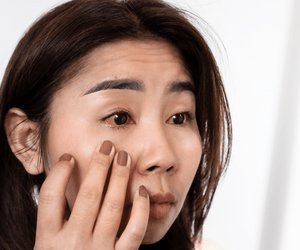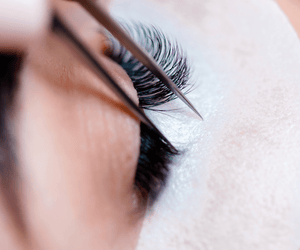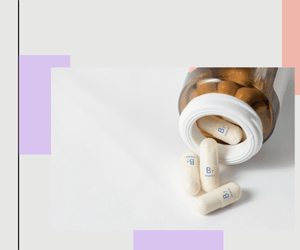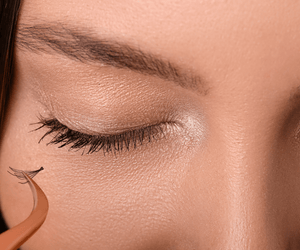If your eyes turn red or start stinging in the blink of an eye, finding lashes that work for you can be tough. There’s a lot that can set your eyes watering when you’re wearing false lashes or extensions — the adhesive itself, debris buildup, and even just the weight and friction.
In this post, we’ll help you problem-solve eyelashes for sensitive eyes, whether you’re applying your own falsies at home or getting professional extensions. We’ll cover all the little things you can do to enjoy fuller, more defined lashes while keeping your eyes feeling great.
Table of Contents
What It Means to Have “Sensitive Eyes” With Lashes
With lashes, having sensitive eyes can mean a few different things. It may mean that your eyes turn red during or after a lash extension application, or it can mean that irritation occurs a few hours or days after an application of either falsies or extensions.
Having sensitive eyes can stem from having an overactive immune response, specific allergies to things like lash adhesives or dust and debris, and even eye conditions like dry eyes or meibomian gland dysfunction.
Signs of Sensitive Reaction
All of these can result in your eyes having a sensitive reaction to eyelash extensions, including:
- A stinging, burning, or itching sensation
- Eyes becoming red or bloodshot
- The skin around the eyes becomes swollen, tight, or dry
- Any severe or long-lasting symptoms or significant discomfort merit medical attention
Lash Extension Triggers
Many possible false lash and lash extension triggers can lead to irritation, depending on the type of sensitivity you experience.
- Adhesive fumes, especially from professional extensions
- Lash contact with eyes
- Debris buildup from improper hygiene
- Heavy lashes
- Rough removal
Choosing Lashes if Your Eyes Are Sensitive
Whether you’re new to lashes or looking to problem-solve previous sensitivity, here are a few tips for choosing sensitive eye-friendly lash extensions or falsies.
False Lashes
- Opt for lightweight styles with natural length and more subdued volume
- Make sure the lash bands themselves are not too heavy
- Consider lash clusters designed for under-lash placement to minimize skin contact with glue
- Opt for latex-free and formaldehyde-free glues
- Conduct a patch test by applying a small dab of glue near the eyes (but keep in mind that allergies often occur with greater exposure).
Choosing Professional Extensions
If you're interested in professional lash extensions for sensitive eyes, vet your lash technician carefully. There are many different professional techniques and tools that can help prevent negative reactions, so ask your stylist about what they offer.
Some green flags include:
- They work in a well-ventilated space
- Maintains strict hygiene standards and can explain how they disinfect their tools
- Always performs a patch test for new clients
- Has hypoallergenic adhesives and adhesive removers
- Uses fans or fume-absorbing gel
- Pads, tapes, and other products designed specifically for sensitive eyes
- Able to explain how they’ll keep your lash map lighter and more comfortable
- Is willing to take breaks during appointments if you need them
- Offers a lash bath at the end of application to clear out the eyes.
Lilac St. Options to Consider
Lilac St. lash clusters are fantastic for sensitive eyes, especially if you want the multi-day wear benefits of extensions with the simplicity of false lashes.
All Lilac St. lashes are made on a thin cotton band to reduce weight, with ultra-fine lash fibers that reduce weight significantly. Here are a few options we think you’ll love, especially if you’re concerned about eye irritation:
Adhesives
The Lilac St. lash extension adhesives are designed for multiple days of wear, with gentle and non-irritating formulas.
The award-winning Eternal Bond glue is the quicker-drying option, so it’s ideal if your eyes are typically sensitive to adhesive fumes. It offers a long hold, but it’s a little tougher to remove.
If your eyes are sensitive to friction, you may prefer the gentler Lock-It Bond. It doesn’t dry as quickly, so it’s also more friendly for newcomers to DIY lash extensions.
Some of our clients with sensitive eyes find that they prefer the clear version of either formula.
Dawn
The Dawn lashes are our lightest, most delicate set. They’re comfortable, natural-looking, and easy to clean.
Feather
With a little more density at the base, Feather lashes deliver just the right oomph and flutter while still feeling weightless.
Daydream
The unique Daydream lashes have a wispy, spiky feel that's extremely trendy these days, but they're still light, comfortable, and easy to clean.
Lilac Lash Bath Kit
Whether you’re rocking professional lashes or DIY lash clusters, daily cleaning is key to protecting your eyes. The Lilac Lash Bath Kit features an eye and lash-safe shampoo to remove debris buildup, a dual-sided ultra-soft cleansing brush and detangling spoolie, and a makeup towel for gentle, frictionless drying.
Home Application Tips for Sensitive Eyes
Whether you’re doing your own lashes at home or seeing a professional, here are a few key tips to help keep your sensitive eyes safe.
Ventilation: The lash adhesives you use at home are usually much lower in fumes compared to professional ones. Even so, when applying, make sure the room is well ventilated. Turn on the bathroom fan or open a window.
Tools: Disinfect your tweezers and other tools before applying. If you’re reusing lashes, make sure to clean them thoroughly.
Applying: Don’t use too much adhesive, and let it get completely tacky before applying to your lashes or lash line. Consider an underlash placement to prevent adhesive contact with skin.
Distance from lashline: If opting for DIY lash extensions with underlash placement, make sure to apply them about 1 mm away from the lash line to prevent contact and friction.
Aftercare To Prevent Irritation
Once your lashes are on, aftercare will play the biggest role in keeping your sensitive eyes feeling good.
Cleanse
When wearing extensions (DIY or professional), cleanse your lashes daily with a lash-safe cleanser. This clears away mites, dust, bacteria, and other debris that can cause eye irritation or infections. Use a cleaning brush to ensure that the cleanser fully penetrates between each lash.
After cleansing, rinse the eyes thoroughly and use a soft cloth to pat the lashes dry — don’t wipe, as that can pull on the lashes.
Avoid friction
Friction can pull off lash extensions and irritate your eyes. Avoid rubbing your eyes or picking at your lashes. Get in the habit of sleeping on your back to avoid friction from the pillow against your eyes.
Eye-Safe Leave-On Products
From skincare to makeup, any heavy products that come in contact with your lashes can leave a residue that can irritate. Additionally, oily products can actually break down the lash glue, resulting in poorer retention. Instead, use oil-free products and try to avoid mascara or water-resistant eyeliner while wearing lashes.
Removal
If you’re wearing regular false lashes, removing them at the end of the night is very important. Use a gentle makeup remover or lash glue dissolver to take them off with minimal pull or friction. With DIY lash extensions, a dedicated lash bond breaker will work best.
When it comes to professional extensions, sometimes the removers used in salons can irritate the eyes, especially as they interact with the adhesive.
When to Stop Getting Lashes
It’s important you get familiar with the signs that you need to stop getting lashes, either in the moment or in general.
During a lash extension application, significant stinging is a sign that the application needs to stop. If there are issues with ventilation or the adhesive itself is too intense, you might be able to just take a break and have your technician switch products.
Afterwards, mild stinging or redness after lash extensions is okay, but lasting irritation, itch, or a grainy feel means you should probably have the lashes removed. If you experience significant swelling or discomfort, vision changes, or systemic symptoms like trouble breathing, seek medical care immediately.
FAQs
What lashes are best for sensitive eyes?
The best lashes for sensitive eyes are lightweight, with delicate fibers and thin bands. More importantly, they can be applied with hypoallergenic adhesives and are easy to clean.
Can you get lash extensions with sensitive eyes?
You can get lash extensions even with sensitive eyes, as long as you’re not allergic to the adhesives your technician uses.
Is clear adhesive better for sensitive eyes?
Yes, clear adhesive is better for sensitive eyes, since sometimes the black pigment itself can be an irritant.
How do I reduce stinging during application?
Your technician can reduce stinging during application by using hypoallergenic adhesives, fans, or fume-absorbing products.
Do lash cleansers irritate sensitive eyes?
While it is possible for a lash cleanser to irritate the eyes, it’s not normal and is likely a sign of a poor-quality product. Your lash cleanser should be eye-safe and should not irritate.
What should I do if irritation won’t go away?
If irritation doesn’t go away within a few hours of your lash extension application, consider getting your lashes or extensions removed. Speak to a doctor if you experience significant or prolonged symptoms.
Are DIY clusters gentler than strips?
DIY lash clusters are often lighter and more delicate than heavier strip lashes. Because they adhere to the lashes themselves rather than the skin, there is also a lower risk of skin irritation. However, because they’re designed for multi-day wear, practicing good hygiene is essential for preventing eye irritation from debris build-up.
How often should I replace/clean tools?
Make sure to clean and disinfect your lash tools before every single application. If you’re applying reusable lashes or lash clusters, clean those thoroughly prior to application as well.








